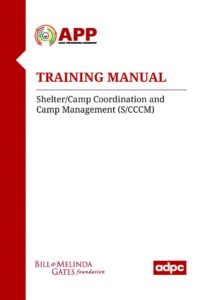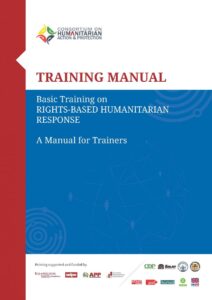Capacity building is one of the most essential approaches to disaster risk management. This understanding has led APP to engage in capacity building as one of its main focus areas. The APP conducted training needs assessments for the Government, LNGOs, the private sector, and civil society groups in a number of its member countries. The research has led to the development of numerous training curriculums tailored to the various and very specific facets of disaster relief. Priority training curricula have been developed and made accessible online in order to expand the local pool of experts in disaster preparedness, response, and recovery. These manuals have been designed in a manner that allows trained individuals to become mentors who can extend these practices across communities.
Shelter/Camp Coordination and Camp Management (S/CCCM)
More than 12.5 million people in South Asia, East Asia, and the Pacific were displaced as a result of disasters. These individuals primarily seek shelter in camps. However, baseline assessments in Cambodia, Pakistan, the Philippines, and Sri Lanka have identified capacity building in camp management as a requirement. The issues arise from the lack of a standardized course in camp management.
The intensity of disasters is increasing in the region and necessitates a regional course on Shelter, Camp Coordination and Camp Management (S/CCCM). The overall goal of the S/CCCM course is to provide guidance, knowledge, and know-how on camp management to humanitarian actors for improving living conditions of disaster-affected people during displacement and camp residency.
Basic Training on RIGHTS-BASED HUMANITARIAN RESPONSE
A Manual for Trainers
The Consortium on Humanitarian Action and Protection (CHAP) has established provisions of the Basic Training on Rights-Based Humanitarian Response (RBHR) in 1996. It was created for humanitarian workers and volunteers need to uphold human rights through applying the humanitarian principles, core humanitarian standards, and rights-based approach (RBA) in humanitarian response work during emergency response.
The Rights-Based Humanitarian Response (RBHR) seeks to train participants and enable them to comprehend emergency response in the context of human rights and disaster risk reduction and management (DRRM) framework, explain the process of emergency assessment, humanitarian response programming, and emergency response management, and discuss how humanitarian workers can be mobilized, nurtured, and sustained for humanitarian response. The manual was designed to guide participants in a manner that would enable them to train others. The manual was developed under the Philippines Preparedness Partnership (PPP).
Disaster Risk Management (DRM) for Pakistan
One of the key focus areas of APP is capacity building. One of the most effective ways to strengthen the capacity is to impart training and develop the necessary skills of every disaster practitioners. These individuals are the first responders and their disaster preparedness for effective response and recovery is essential.
The Pakistan Resilience Partnership (PRP), The national chapter of APP in Pakistan has been organizing regular capacity building initiatives with the aim to increase understanding and knowledge of stakeholders across the spectrum of disasters. Pakistan is the eighth-most affected country by extreme weather events. The nation has suffered from almost $18 billion in terms of damages and losses due to disasters in the last decade according to the World Bank. The training manual was developed to provide all-encompassing training material that can be used in training for an entire spectrum of disaster management for Pakistan.
Protection against Lightning
Lightning is one of the major causes of disaster-related deaths in Nepal. It is also a threat to livestock and communication lines. ADPC took the initiative to educate individuals across sectors. It started with understanding the risk, identifying the status of the public awareness and technical knowledge of safety measures and protection, and proposing a strategic roadmap for raising the level of awareness and strengthening the capacities for appropriate protective measures.
The training manual on Protection Against Lightning (PaL) contains comprehensive information about basic protection mechanisms against lightning, causes of lightning and its impacts, and disaster risk management (DRM) related government policies and institutional mechanisms in Nepal. The manual was published with the support, knowledge, and cooperation of the Government of Nepal and experts working on PaL in Nepal.



